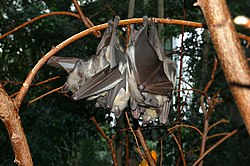Kasanka National Park
The privately funded Kasanka Trust Ltd has been in operation since 1986 and undertakes all management responsibilities, in partnership with the Department of National Parks and Wildlife (DNPW - previously ZAWA).
[1] It has a relatively flat topography with few noteworthy relief features, with the exception of the Mambilima Falls located close to the Kasanka Conservation Centre and the rocky Mpululwe and Bwalya Bemba hills.
A high frequency of fires removes this stratum and young saplings and leads to Miombo Woodland with large, widely separated trees.
Decades of “early burning” in the park have resulted in more natural Miombo with a strong presence of young trees and thicket species.
Kasanka is perhaps the best place in the world to spot the shy and reclusive sitatunga, of which the park holds an estimated 500-1,000 animals, and offers great opportunities for sightings of the rare blue monkey.
[8] Elephant are faring increasingly well and several breeding herds and bachelor bulls traverse the park and the surrounding game management area.
Several of the plains like Chikufwe are home to common reedbuck, buffalo, sable antelope and Lichtenstein's hartebeest, which are often encountered in the dry season.
Roan antelope, defassa waterbuck and Sharpe's grysbok occur but are rare and seldom seen, whereas warthog numbers are increasing and they are commonly sighted.
The first of Kasanka’s famous straw-coloured fruit bats (Eidolon helvum) start arriving towards the middle of October each year.
[10] The bat roost is centred on one of the largest remaining patches of Mushitu (indigenous forest) in Kasanka along the Musola stream.
A study published in the African Journal of Ecology indicated that the migratory impact of the bats could ultimately threaten the viability of the seasonal roost as it increases faster tree mortality.
The vast wetlands of Kasanka support some species not easily seen elsewhere such as rufous-bellied heron, lesser jacana and African pygmy goose.
Marsh tchagra, coppery-tailed coucal, Fulleborn's longclaw, locustfinch, pale-crowned, croaking and short-winged cisticola, chestnut-headed and streaky-breasted flufftail, harlequin and blue quail, black-rumped buttonquail and fawn-breasted waxbill are amongst the other specials on the wetland fringes and in the large dambos.
[14] The Mushitu is host to a wide range of other species, the sought-after Narina trogon can often be heard and seen in the small patches of forest close to Pontoon and Fibwe.
A range of other species occur such as blue-mantled crested flycatcher, Schalow's turaco, brown-headed apalis, black-backed barbet, grey waxbill, Bocage's robin, West African (olive) thrush, dark-backed weaver, red-throated twinspot, green twinspot, red-backed mannikin, green-headed sunbird, yellow-rumped tinkerbird, scaly-throated honeyguide, pallid honeyguide, purple-throated cuckooshrike, black-throated wattle-eye, yellow-throated leaflove and little, grey-olive, yellow-bellied and Cabanis's greenbul.
This manifest in the form of increasing poaching and illegal harvesting from national parks, encroachment, and deforestation due to charcoal production and farming activities.
During the 1980s, the Zambian administration faced a shortage of trained staff, transport and patrols, leading the government to seek the support of NGOs and private bodies.
[15] After visiting the neglected and completely undeveloped Kasanka National Park for the first time in 1985 and hearing gunshots, the late David Lloyd, a British colonial officer, impressed with the wide range of habitats and amazing scenery, concluded that if there was still poaching, there must still be wildlife.
[15] DNPW retains the responsibilities for anti-poaching work in the park and surrounding Game Management Area in conjunction with the Trust.
The Kasanka Trust aims to cover its costs through tourism-generated revenue, however it is still reliant on external funding from grants and donations for part of its budget.
[16] Since KTL's involvement at Kasanka significant progress has been made, a vast network of roads has been created as well as an excellent tourist-infrastructure, a community conservation centre and the implementation of effective anti-poaching measures.
In 2011 Kasanka Trust began operations in the undeveloped and depleted 1,600 km2 Lavushi Manda National Park with assistance from the World Bank.




